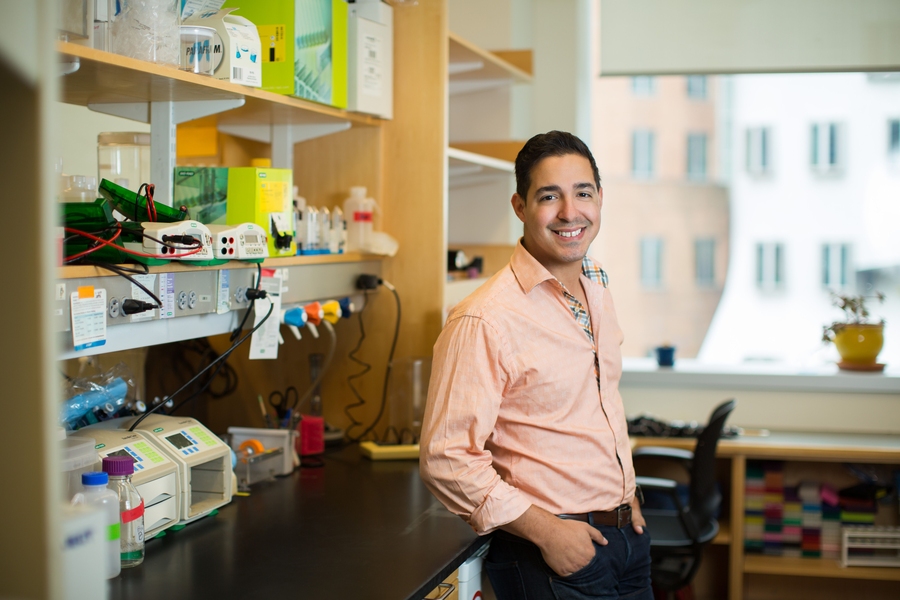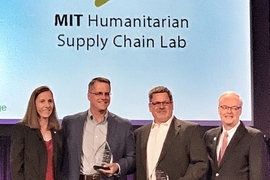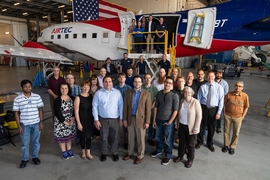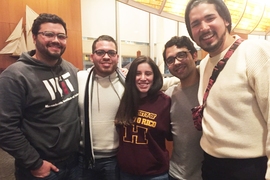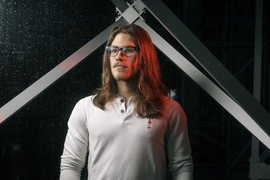When Hurricane Maria hit Puerto Rico in September 2017, Héctor De Jesús-Cortés was vacationing on the island with his wife, Edmarie Guzmán-Vélez. “Worst vacation ever, but it actually turned out to be the most important in my life,” says De Jesús-Cortés. In the days immediately after the hurricane, both focused on helping their families get their bearings; after that first week, however, they were itching to do more. That itch would take them to San Juan, Puerto Rico’s capital, where they asked the then-secretary of education a simple question: “How can we help?”
With De Jesús-Cortés’ PhD in neuroscience and Guzmán-Vélez’s PhD in clinical psychology, they soon became involved in an effort led by the Department of Education to help students and school staff, as well as the community at large, troubled by the hurricane. “Everyone was traumatized, so if you bring kids to teachers who are also traumatized, that’s a bad recipe,” explains De Jesús-Cortés.
De Jesús-Cortés and Guzmán-Vélez connected with their friend Rosaura Orengo-Aguayo, a clinical psychologist and assistant professor at the Medical University of South Carolina who studies traumatic stress and Hispanic populations. Working together with the Department of Education and the U.S. Department of Health and Human Services, they developed a program to address trauma in schools. The Esperanza, or “promise,” program is ongoing and has already trained hundreds of school staff members on how to manage trauma and anxiety, and to identify these manifestations in students.
Back in Boston, De Jesús-Cortés has continued his efforts for Puerto Rico, raising funds for micro-entrepreneurs and teaching neuroscience in online classes for undergraduates on the island. Each effort is guided by that same simple question — How can we help? His latest effort along with Guzmán-Vélez is a precollege summer program at MIT that will give Puerto Rican students a taste for scientific research.
A sense of possibility
For De Jesús-Cortés, teaching is more than just a transfer of knowledge. “I see teaching as mentorship,” he says. “I want students to be exposed to opportunities, because growing up in Puerto Rico, I know how difficult it can be for some students to get those opportunities.”
While De Jesús-Cortés was an undergraduate at the University of Puerto Rico, he participated in Minority Access for Research Careers (MARC), a National Institutes of Health-funded program that supports underrepresented minority undergraduates as they move toward careers in biomedical sciences. “We had workshops every month about applications; they would bring recruiters, and they would also pay for summer internships,” explains De Jesús-Cortés.
MARC allowed De Jesús-Cortés to see a career in science as a possibility, and he envisions that the summer school, whose inaugural class will be in summer 2020, will do something similar. “The idea is to have kids first spend two weeks in Puerto Rico and expose them to research at the undergraduate level,” explains De Jesús-Cortés. The students will be at the Universidad del Sagrado Corazón in Puerto Rico; the university has partnered with De Jesús-Cortés on the project. “Then they travel to Boston and see what research is happening here.” The 15-20 students will spend two weeks in Massachusetts, living in the MIT dorms, visiting labs, and learning how to apply to colleges in the United States.
The MARC program also gave De Jesús-Cortés a community. “To this day, I talk to my MARC fellows,” he says, and that’s something he hopes to replicate with the summer students. “Each student will have a mentor, and I want them to keep talking after the program,” De Jesús-Cortés says.
The summer school will not just give students a taste of scientific research, it will also show that universities like MIT are within their reach. “I was born and raised in Puerto Rico, and my schools didn't have the best resources in STEM,” De Jesús-Cortés says. He hopes that, by seeing researchers in Greater Boston that have the same background, the summer students will see MIT and a career in science as a possibility. “Students need to be exposed to mentors and role models that prove that it can be done,” he says.
Fixing vision
De Jesús-Cortés works on the summer school, and his other efforts for Puerto Rico and the Latino community, in addition to his neuroscience research. As a postdoc in the lab of Mark Bear, the Picower Professor of Neuroscience, he’s trying to use electrophysiology to figure out when neurons in the brain need a little help to communicate.
Neurons communicate with one another using both chemical and electrical activity. An action potential, which is electrical, travels down the arms of the neuron, but when it reaches the end of that arm, the synapse, the communication becomes chemical. The electrical signal stimulates the release of neurotransmitters, which reach across the gap between two neurons, stimulating the neighboring neuron to make its own action potential.
Not every neuron is equally capable of producing action potentials. “In a neurodegenerative disorder, before the neuron dies, it’s sick,” says De Jesús-Cortés. “And if it’s sick, it’s not going to communicate electrically very well.” De Jesús-Cortés wants to use this diminished electrical activity as a biomarker for disorders in the brain. “If I can detect that diminished activity with an electrode, then I can intervene with a pharmacological agent that will prevent the death of neurons,” he explains.
To test this, De Jesús-Cortés is focusing on amblyopia, a condition more commonly known as lazy eye. Lazy eye happens when the communication between the visual cortex — a region in the back of the brain where visual information is received and processed — and one of the eyes is impaired, resulting in blurred vision. Electrical activity in the visual cortex that corresponds to the lazy eye is also down, and De Jesús-Cortés can detect that decreased activity using electrodes.
When amblyopia is caught early on, a combination of surgery and an eye patch can strengthen the once-lazy eye, getting rid of the blurriness. “But, if you catch that condition after 8 years old, the patching doesn’t work as well,” says De Jesús-Cortés. Another postdoc in the Bear Lab, Ming-fai Fong, figured out that tetrodotoxin, which is found in puffer fish, is able to reboot the lazy eye, bringing up electrical activity in the visual cortex and giving mice with amblyopia perfect vision mere hours after receiving a drop of the toxin.
But we don’t actually know how tetrodotoxin is doing this on a molecular level. “Now, putting tetrodotoxin in humans will be a little bit difficult,” says De Jesús-Cortés. Add too much toxin and you could cause a number of new problems. He is investigating what exactly the toxin is doing to sick neurons. Using that information, he then wants to design alternative treatments that have the same or even better effect: “Find neurons that are quiet because they are sick, and reboot them with a pharmacological agent,” he says.
In the future, De Jesús-Cortés wants to look beyond the visual cortex, at other regions of the brain and other conditions like Parkinson, Alzheimer’s, and autism, finding the hurting neurons and giving them a boost.
In both his neuroscience research and his work for Puerto Rico, De Jesús-Cortés is passionate about finding ways to help. But he has also learned that for all these efforts to succeed, he needs to accept help as well. “When you are working on so many projects at the same time, you need a lot of different people that believe in your vision,” he says. “And if you’re helping them, you believe in their vision.” For De Jesús-Cortés, this reciprocity is one of the most important aspects of his work, and it’s a guiding principle in his research and life. “I believe in collaboration like nothing else."
